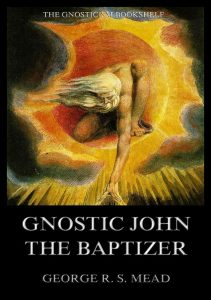Gnostic John the Baptizer: Selections from the Mandaean John-Book – G. R. S. Mead
The main materials contained in these pages will certainly be new for the vast majority of readers. Moreover the Mandaean narratives, legends and discourses are not only interesting because of their own distinctive matter and manner, but they are also arresting; for they raise a number of problems, some of which are far-reaching and one is fraught with implications of immense importance. The definite solutions of these problems, however, lie in the future, and the most important of them will perhaps never be reached; for, in the absence of straightforward historical information, general agreement on any subject that concerns Christian origins immediately or even indirectly is now well-nigh a psychological impossibility.
Format: Paperback.
Gnostic John the Baptizer: Selections from the Mandaean John-Book.
ISBN: 9783849673253.
G. R. S. Mead and the Theosophical Society (from wikipedia.com)
While still at Cambridge University Mead read Esoteric Buddhism (1883) by Alfred Percy Sinnett. This comprehensive theosophical account of the Eastern religion prompted Mead to contact two theosophists in London named Bertam Keightly and Mohini Chatterji, which eventually led him to join Helena Petrovna Blavatsky’s Theosophical Society in 1884.
In 1889 he abandoned his teaching profession to become Blavatsky’s private secretary, and also became a joint-secretary of the Esoteric Section (E.S.) of the Theosophical Society, reserved for those deemed more advanced.
Mead received Blavatsky’s Six Esoteric Instructions and other teachings at 22 meetings headed by Blavatsky which were only attended by the Inner Group of the Theosophical Society. It was because of the intimacy Mead felt with the Inner Group that he married Laura Cooper in 1899.
Contributing intellectually to the Theosophical Society, at first most interested in Eastern religions, he quickly became more and more attracted to Western esotericism in religion and philosophy, particularly Neoplatonism, Gnosticism, and Hermeticism, although his scholarship and publications continued to engage with Eastern religion. Making many contributions to the Theosophical Society’s Lucifer as joint editor, he eventually became the sole editor of The Theosophical Review in 1907 (as Lucifer was renamed in 1897).
As of February 1909 Mead and some 700 members of the Theosophical Society’s British Section resigned in protest at Annie Besant’s reinstatement of Charles Webster Leadbeater to membership in the society. Leadbeater had been a prominent member of the Theosophical Society until he was accused in 1906 of teaching masturbation to the sons of some American Theosophists under the guise of occult training. While this prompted Mead’s resignation, his frustration at the dogmatism of the Theosophical Society may also have been a major contributor to his break after 25 years.
(The text of the last section was taken from a Wikipedia entry and is available under the the Creative Commons Attribution-ShareAlike License.)
Publisher’s Note: This book is printed and distributed by Createspace a DBA of On-Demand Publishing LLC and is typically not available anywhere else than in stores owned and operated by Amazon or Createspace.

